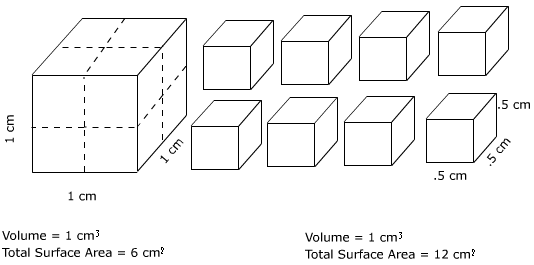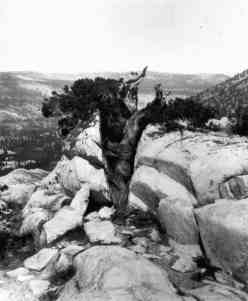|
Weathering, Erosion, and Mass Movement Physical weatheringThe result of physical weathering is to simply make smaller pieces out of larger ones. In so doing, physical weathering makes it easier for surface materials to chemically decompose and be eroded. When a large block of material is broken into smaller pieces additional surface area for chemical weathering to act is exposed. Examine Figure 17.2 below. On the left is a block whose length, width and height is equal to one centimeter. This means that the volume of the block is equal to 1 cubic centimeter and the total surface area is equal to 6 square centimeters. If we split the block in length and width wise (dashed lines) we create eight smaller pieces, each with a height, width, and depth of .5 centimeters. Though the volume of all eight pieces taken together is still 1 cubic centimeter, the total amount of surface area is greatly increased to 12 cm2.
Figure 17.2 Effect of particle size and surface area. Physical weathering processesThere are a number of physical weathering processes that break earth materials apart,
a
very common one is called root wedging.
Plant roots work
their way into rock crevices called joints. As they grow, roots create pressure on the sides of
the crack enlarging it until the rock breaks apart. This is a common problem
for home owners where trees are grow too close to a house. Tree roots can force
their way into the foundation, breaking it apart, and let water seep into the owner's basement.
Frost wedging occurs when water freezes in rock fractures. As the water freezes it expands putting pressure on the sides of the crack, enlarging it until the rock breaks apart. Thermal expansion and contraction can weaken rock and cause it to disintegrate. In deserts, surface materials get exceedingly hot during the day and be exposed to cold temperatures at night. The expansion upon heating and contraction during cooling weakens rock breaking it apart. Alternate wetting and drying causes material to expand and contract, thus weakening rocks and inducing them to break as well. Regardless of process, the result is a mass of unconsolidated material. |
Help keep this site available by donating through PayPal.

This work is licensed under a Creative Commons Attribution-ShareAlike 4.0 International License..

 Figure 17. 3 Tree roots growing into bedrock. Courtesy USGS DDS21
Figure 17. 3 Tree roots growing into bedrock. Courtesy USGS DDS21